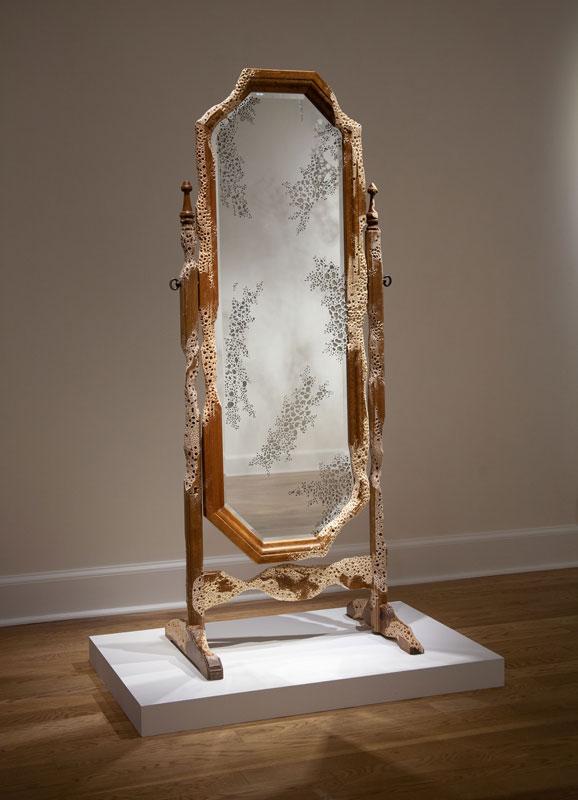I had lofty dreams when I applied to the Arkansas Committee of the National Museum of Women in the Arts 2023 Artist Award. I was going to start my second wearable sculpture fashion line and rent a larger studio to accommodate my massive vision. Little did I know a week after being awarded the grant I would have unexpected surgery to remove my gallbladder, from which I am still recovering.
Thanks to the flexible unrestricted nature of the grant, instead of expanding my studio space I was able to save my existing space. Being out of work for close to two months post-surgery, the grant could not have come at a more opportune time.
It is frustrating that the physical limitation of my body has heavily impacted my studio practice this past year and persists. I am also not oblivious to the irony of the whole situation. This is the content of my artwork. Whether it is abstract or representational, my work revolves around the invisible fragility and resilience of the human body.
I had limited mobility and strength for the first four months after my surgery and had to look for alternative solutions for creating artwork. Sewing, welding, and woodworking were not an option. My studio practice took on an explorative nature and I experimented with new mediums and used digital fabrication (3D modeling, 3D printing, CO2 lasers, CNC routing). I had always viewed digital fabrication as a tool, but this ability to accommodate my disability gave me a new level of respect. As I worked, I saw old motifs of my work resurface and explored them translated into new mediums, which led to extraordinary discoveries and opportunities.
“…the grant could not have come at a more opportune time.” – Shelby Fleming
With limited mobility and stamina, the first few months I turned to linocut reduction as a means of creation. It was extremely slow for me, but each butter smooth cut of the linoleum was satisfying and addictive. One block turned into five, then 10, each one depicting my cellular motif. I thought of the collection of blocks as puzzle pieces; yes, it could be printed over and over but when printed and collaged in with the rest of the blocks, the pattern became unique and original with each new print. The work evolved into fabric bags and clothing to tie the work back to the body.
Alongside printmaking, I started to incorporate 3D printing into my practice. Using the same cellular motif, I translated my drawings into 3D models and 3D printed them. I used a similar concept to the prints, creating individual parts that when constructed in layers, gave each and every piece a uniqueness that could not be replicated.

Slowing down in the studio also gave me the opportunity to revisit unresolved pieces and bodies of work that I had set aside. I finished a few new pieces in my “Micro Escape” photo drawing series that was later on display at Interform Atelier and one of the pieces was selected to be a part of the permanent collection of the newly opened Washington County Children’s Safety Center.
In the fall, I was a presenter at Maker Faire NWA on the topic of “How Digital Fabrication Has Changed Art Making.” In the presentation, I was able to express how it had made my studio practice more accessible and made previously inconceivable ideas a reality. The highlight of my year was presenting a solo show at Arts on Main in Van Buren. I wanted it to manifest the unseen complications I had been facing all year while still demonstrating my determined nature to persevere. I thought it was then only fitting that the title of the exhibit be Bold and Brittle.

I remember when the gallery reached out, I was hesitant to accept, unsure if I would physically be able to install my work. The prospect gave me an overwhelming motivation to focus on my healing and dietary adjustment so I would be ready. I was able to finish a new piece in my series, The Break Down titled, “Osteoporosis: Mirror.” In this piece, I combined my traditional wood carving techniques and incorporated digital fabrication to etch the mirror with a CO2 laser so the viewer could see through the mirror.
Another highlight of the show for me was installing “Brittle,” my 24-foot plaster installation. I had installed it previously, but this was the first time there were walls around the piece instead of glass. It gave me the opportunity to paint the gallery with cast shadows.
In conclusion, I would like to thank all the members of the ACNMWA for their dedication to supporting Arkansas women artists and for giving us the opportunities to share our stories through art. I also want to give a large thank you to the strongest woman in my life, my mom. Thank you for helping me recover during my surgery and for always supporting me in my artistic visions.





